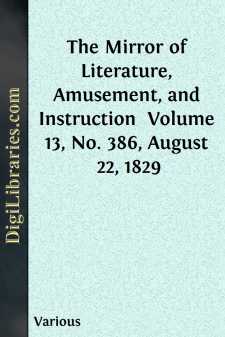Categories
- Antiques & Collectibles 13
- Architecture 36
- Art 48
- Bibles 22
- Biography & Autobiography 813
- Body, Mind & Spirit 142
- Business & Economics 28
- Children's Books 17
- Children's Fiction 14
- Computers 4
- Cooking 94
- Crafts & Hobbies 4
- Drama 346
- Education 46
- Family & Relationships 57
- Fiction 11829
- Games 19
- Gardening 17
- Health & Fitness 34
- History 1377
- House & Home 1
- Humor 147
- Juvenile Fiction 1873
- Juvenile Nonfiction 202
- Language Arts & Disciplines 88
- Law 16
- Literary Collections 686
- Literary Criticism 179
- Mathematics 13
- Medical 41
- Music 40
- Nature 179
- Non-Classifiable 1768
- Performing Arts 7
- Periodicals 1453
- Philosophy 64
- Photography 2
- Poetry 896
- Political Science 203
- Psychology 42
- Reference 154
- Religion 513
- Science 126
- Self-Help 84
- Social Science 81
- Sports & Recreation 34
- Study Aids 3
- Technology & Engineering 59
- Transportation 23
- Travel 463
- True Crime 29
The Mirror of Literature, Amusement, and Instruction Volume 13, No. 386, August 22, 1829
by: Various
Categories:
Description:
Excerpt
ST. PETER'S CHURCH, PIMLICO.
The engraving represents the new church on the eastern side of Wilton Place, in the Parish of St. George, Hanover Square. It is a chaste building of the Ionic order, from the designs of Mr. Henry Hakewill, of whose architectural attainments we have frequently had occasion to speak.
The plan of St. Peter's is a parallelogram, placed east and west, without aisles; the east being increased by the addition of a small chancel flanked by vestries. The west front, in our Engraving, is occupied by an hexastyle portico of the Ionic order, with fluted columns. The floor is approached by a bold flight of steps, and in the wall, at the back are three entrances to the church. The columns are surmounted by their entablature and a pediment, behind which a low attic rises from the roof of the church to the height of the apex of the pediment; it is crowned with a cornice and blocking-course, and surmounted by an acroterium of nearly its own height, but in breadth only equalling two-thirds of it; this is finished with a sub-cornice and blocking-course, and is surmounted by the tower, which rises from the middle. The addition of a steeple to a Grecian church forms a stumbling-block to our modern architects, forcing them to have recourse to many shifts to convert a Grecian temple into an English church, a forcible argument for the rejection of the classical styles altogether in this species of buildings. Mr. Hakewill has, however, in part surmounted this difficulty, and the effect produced is not bad, as great value is given to the front elevation by it.
The tower consists of a square in plan, in elevation consisting of a pedestal, the dado pieced for the dials of a clock, sustaining a cubical story, with an arched window in each face, at the sides of which are Ionic columns, the angles being finished in antis. This story is crowned with an entablature, above which rises a small enriched circular temple; the whole is crowned with a spherical dome, surmounted by a cross.
The body of the church is built of brick, with stone dressings. The interior is chastely fitted up. The altarpiece is Mr. Hilton's splendid picture of "Christ crowned with thorns," exhibited at Somerset House, in 1825, and presented to this church by the British Institution in 1827.
The ground for the site was given by Lord Grosvenor, and the sum of 5,555l. 11s. 1d. was granted by the Royal Commissioners towards the building. It will accommodate 1,657 persons. The first stone was laid September 4, 1824, and the church was consecrated by the Bishop of London, (Dr. Howley,) July 20, 1827.
PSALMODY.
(To the Editor of the Mirror.)
I have lately made a journey to the metropolis for the purpose of inquiring by my own personal attention and otherwise, whether any improvement had been made in the Psalmody of any of the numerous new churches and chapels in and near London. I have visited by far the greater part of them. In many of them I find no improvement, but there are two or three which merit distinction....












